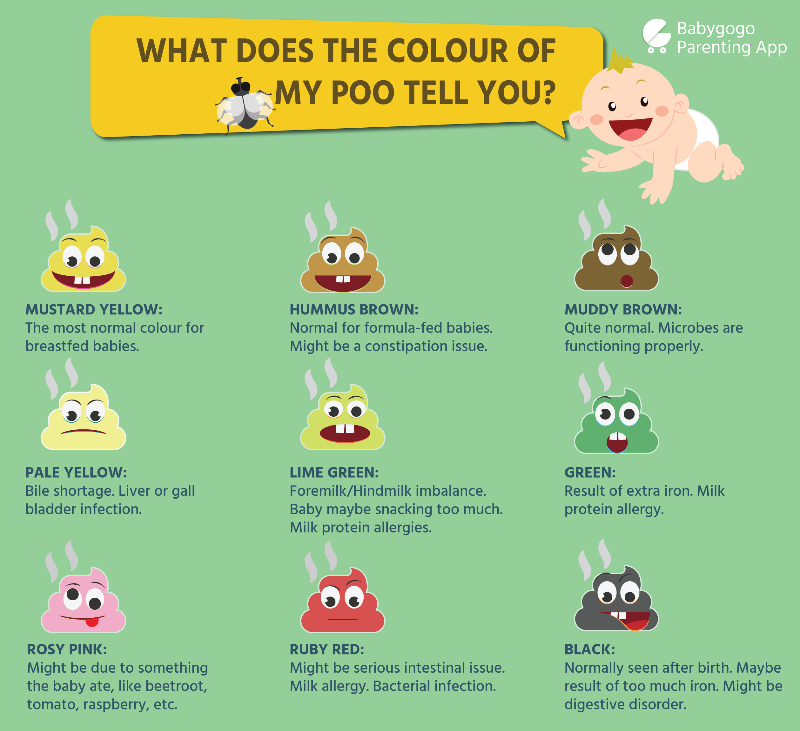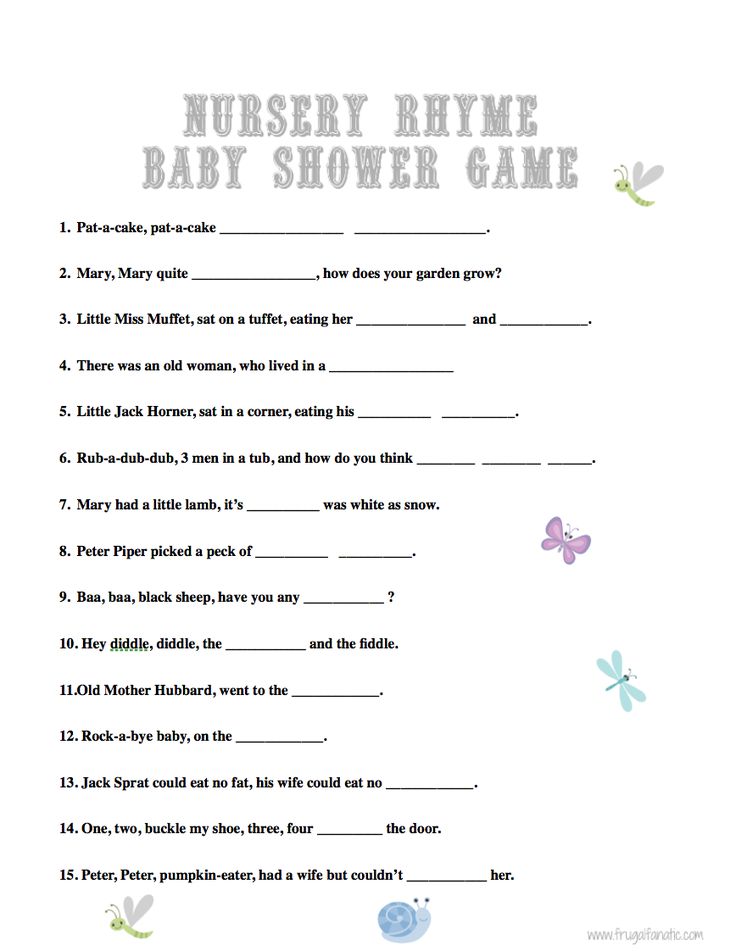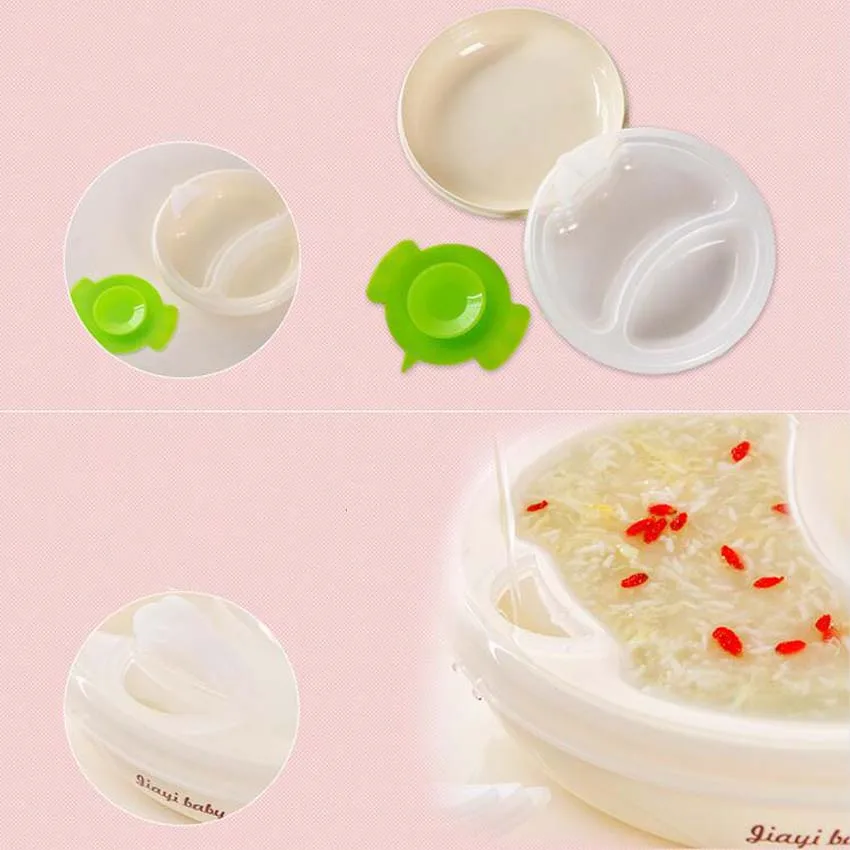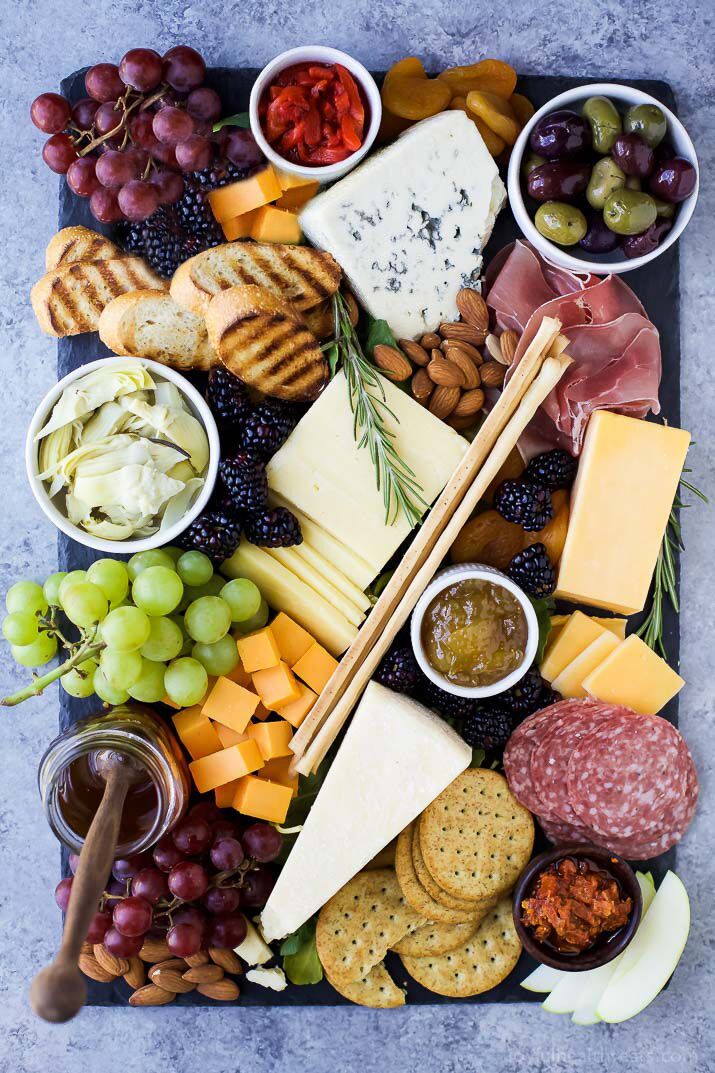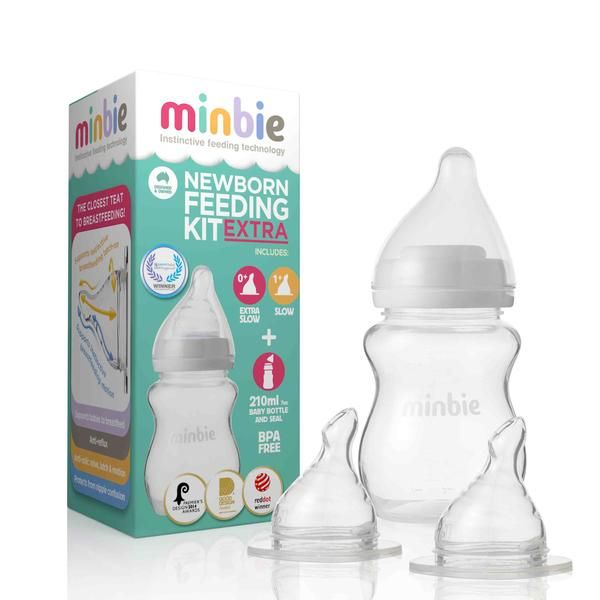Food chart for 6 months old baby boy
6 Months Old Baby Food Chart Along with Recipes
Congratulations, your baby has hit the half-year milestone. In the first six months, she has gained all the nutrients from breast milk. It is now time for your baby to start tasting solids and relish them.
Also Read: 6 Months Old Baby Milestones
Video: Food Ideas for 6 Months Old Baby
Nutrient Requirements of a 6-Month-Old Infant
Here are the nutritional components that 6-month-old baby food should have:
- Calcium: Calcium is essential for bone and teeth development.
- Iron: Iron helps to carry oxygenated blood to developing parts of the body.
- Zinc: Zinc improves cell repair and growth.
- Fat: Fat insulates the baby and stimulates brain development.
- Carbohydrates: Carbohydrates provide energy for doing day-to-day activities.
- Protein: Proteins act as building blocks for cells.
- Vitamins: Different vitamins contribute differently to a baby’s growth. Vitamin A, B1, B2, B3, B6, B12, C, D, E and K are essential to a baby.
- Minerals: Minerals like sodium and potassium directly influence the growth of a baby.
Also Read: Developmental Activities for 6 Month Old Baby
How Much Food Should Your Baby Eat?
A six-month-old baby is primarily breastfed or formula-fed. However, solid food can be introduced for breakfast or lunch. Introduce only one fruit or vegetable and feed it to your baby for at least three days. If she responds well and does not show any signs of allergy, then you can continue with that fruit or vegetable and also try other foods.
Best Foods for a 6-Month-Old Baby
Expert paediatricians recommend avoiding salt and sugar until the age of one, as it puts unwanted stress on the kidneys.
Some healthy food options for 6 months+ babies include:
- Fruits Puree: Fruits should be steamed, and mashed or pureed while introducing for the first time. Fruits like apples, bananas, pear, avocado, chikoo and peaches can be given.
- Vegetable Puree: Vegetables such sweet potatoes, potatoes, carrots, sweet pumpkin, french beans, etc. can be steamed and given either as finger foods or as a puree.
- Pulses Soup: A variety of pulses, especially dals, can be boiled with water and the soup can be given to babies.
- Rice Porridge: Rice is a good source of carbohydrates and vitamins for babies. Broken rice, made with breast milk or formula milk can be given as porridge.
- Cereal Porridge: Porridge can also be made from a variety of single grain cereals like wheat, millet, barley, oats, etc. These cereals can be dried and powdered together or separately, to make gruel.
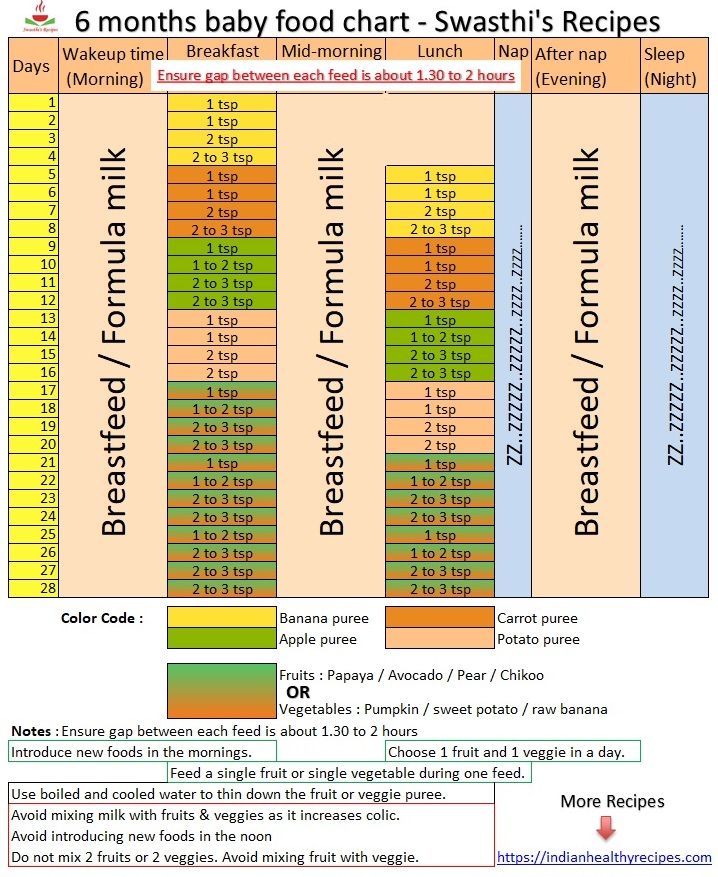
- Vegetable Soup: A variety of vegetables can be boiled in water, and the stock can be given as soup.
- Yoghurt: Although cow’s milk is not recommended until the age of one, unsweetened yoghurt can be given in moderate amounts as an alternative to purees.
What If Your Baby Is Allergic to Particular Foods?
An allergic reaction can occur in the form of diarrhoea, vomiting, rashes, constipation or pain in the stomach and is a cause for concern. If there is an allergic reaction, stop the food that you have been giving the baby immediately. If the allergic reaction persists, seek medical assistance. You can retry it after a few months if your paediatrician gives the go-ahead.
Also Read: Effective Tips to Take Care of 6 Months Old Baby
Video: Diet Plan for a 6-Month-Old Baby
6-Month-Old Baby Food Chart/Meal Plan
You can prepare a meal plan or chart for your baby’s meals and follow it as much as possible.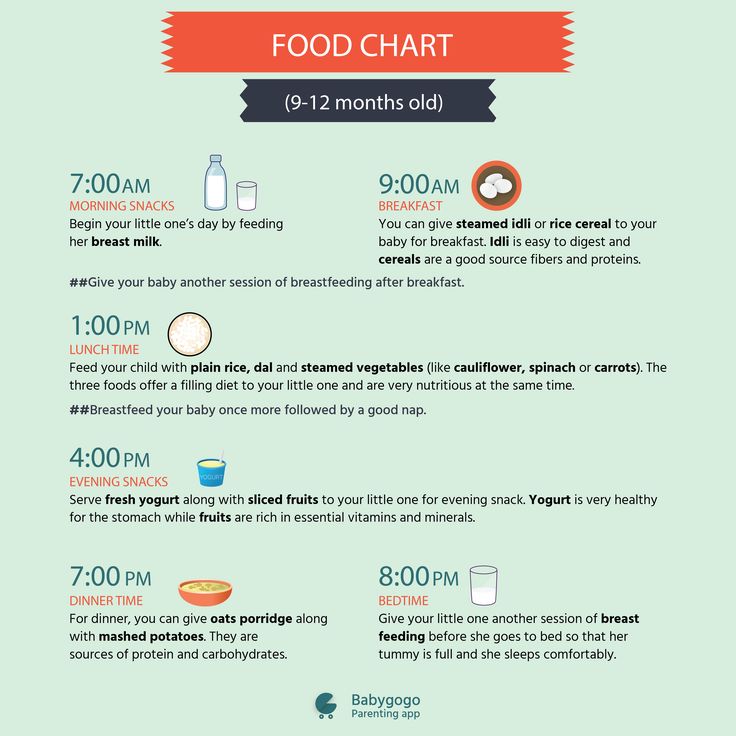 The chart below can help you design your own 6-month-old baby food schedule according to your baby’s preferences.
The chart below can help you design your own 6-month-old baby food schedule according to your baby’s preferences.
Diet for a 6-month-old – Week 1, Day 1
| Early morning | Mother’s milk /formula feed |
| Breakfast | Stewed apple |
| Mid-morning | Mother’s milk /formula feed |
| Lunch | Mother’s milk /formula feed |
| Evening | Mother’s milk /formula feed |
| Dinner | Mother’s milk /formula feed |
Diet for a 6-month-old – Week 1, Day 2
| Early morning | Mother’s milk /formula feed |
| Breakfast | Stewed apple |
| Mid-morning | Mother’s milk /formula feed |
| Lunch | Mother’s milk /formula feed |
| Evening | Mother’s milk /formula feed |
| Dinner | Mother’s milk /formula feed |
Diet for a 6-month-old – Week 1, Day 3
| Early morning | Mother’s milk /formula feed |
| Breakfast | Stewed apple |
| Mid-morning | Mother’s milk /formula feed |
| Lunch | Mother’s milk /formula feed |
| Evening | Mother’s milk /formula feed |
| Dinner | Mother’s milk /formula feed |
Diet for a 6-month-old – Week 1, Day 4
| Early morning | Mother’s milk /formula feed |
| Breakfast | Stewed apple |
| Mid-morning | Mother’s milk /formula feed |
| Lunch | Moong dal (yellow split gram) soup |
| Evening | Mother’s milk /formula feed |
| Dinner | Mother’s milk /formula feed |
Diet for a 6-month-old – Week 1, Day 5
| Early morning | Mother’s milk /formula feed |
| Breakfast | Stewed apple |
| Mid-morning | Mother’s milk /formula feed |
| Lunch | Moong dal (yellow split gram) soup |
| Evening | Mother’s milk /formula feed |
| Dinner | Mother’s milk /formula feed |
Diet for a 6-month-old – Week 1, Day 6
| Early morning | Mother’s milk /formula feed |
| Breakfast | Stewed apple |
| Mid-morning | Mother’s milk /formula feed |
| Lunch | Moong dal (yellow split gram) soup |
| Evening | Mother’s milk /formula feed |
| Dinner | Mother’s milk /formula feed |
Diet for a 6-month-old – Week 1, Day 7
| Early morning | Mother’s milk /formula feed |
| Breakfast | Stewed pear |
| Mid-morning | Mother’s milk /formula feed |
| Lunch | Dal (lentil) -spinach soup |
| Evening | Mother’s milk /formula feed |
| Dinner | Mother’s milk /formula feed |
Diet for a 6-Month-Old – Week 2, Day 1
| Early morning | Mother’s milk /formula feed |
| Breakfast | Stewed pear |
| Mid-morning | Mother’s milk /formula feed |
| Lunch | Dal (lentil) -spinach soup |
| Evening | Mother’s milk /formula feed |
| Dinner | Mother’s milk /formula feed |
Diet for a 6-Month-Old – Week 2, Day 2
| Early morning | Mother’s milk /formula feed |
| Breakfast | Spinach-pumpkin puree |
| Mid-morning | Mother’s milk /formula feed |
| Lunch | Stewed apple |
| Evening | Mother’s milk /formula feed |
| Dinner | Mother’s milk /formula feed |
Diet for a 6-Month-Old – Week 2, Day 3
| Early morning | Mother’s milk /formula feed |
| Breakfast | Spinach-pumpkin puree |
| Mid-morning | Mother’s milk /formula feed |
| Lunch | Stewed pear |
| Evening | Mother’s milk /formula feed |
| Dinner | Mother’s milk /formula feed |
Diet for a 6-Month-Old – Week 2, Day 4
| Early morning | Mother’s milk /formula feed |
| Breakfast | Spinach-pumpkin puree |
| Mid-morning | Mother’s milk /formula feed |
| Lunch | Rice porridge |
| Evening | Mother’s milk /formula feed |
| Dinner | Mother’s milk /formula feed |
Diet for a 6-Month-Old – Week 2, Day 5
| Early morning | Mother’s milk /formula feed |
| Breakfast | Stewed apple |
| Mid-morning | Mother’s milk /formula feed |
| Lunch | Rice porridge |
| Evening | Mother’s milk /formula feed |
| Dinner | Mother’s milk /formula feed |
Diet for a 6-Month-Old – Week 2, Day 6
| Early morning | Mother’s milk /formula feed |
| Breakfast | Mashed potato |
| Mid-morning | Mother’s milk /formula feed |
| Lunch | Rice porridge |
| Evening | Mother’s milk /formula feed |
| Dinner | Mother’s milk /formula feed |
Diet for a 6-Month-Old – Week 2, Day 7
| Early morning | Mother’s milk /formula feed |
| Breakfast | Mashed potato |
| Mid-morning | Mother’s milk /formula feed |
| Lunch | Dal (lentil) -spinach soup |
| Evening | Mother’s milk /formula feed |
| Dinner | Mother’s milk /formula feed |
Diet for a 6-Month-Old – Week 3, Day 1
| Early morning | Mother’s milk /formula feed |
| Breakfast | Stewed pear |
| Mid-morning | Mother’s milk /formula feed |
| Lunch | Rice porridge with mashed carrot |
| Evening | Mother’s milk /formula feed |
| Dinner | Mother’s milk /formula feed |
Diet for a 6-Month-Old – Week 3, Day 2
| Early morning | Mother’s milk /formula feed |
| Breakfast | Spinach-pumpkin puree |
| Mid-morning | Mother’s milk /formula feed |
| Lunch | Rice porridge with mashed carrot |
| Evening | Mother’s milk /formula feed |
| Dinner | Mother’s milk /formula feed |
Diet for a 6-Month-Old – Week 3, Day 3
| Early morning | Mother’s milk /formula feed |
| Breakfast | Stewed apple |
| Mid-morning | Mother’s milk /formula feed |
| Lunch | Rice porridge with mashed carrot |
| Evening | Mother’s milk /formula feed |
| Dinner | Mother’s milk /formula feed |
Diet for a 6-Month-Old – Week 3, Day 4
| Early morning | Mother’s milk /formula feed |
| Breakfast | Carrot-beetroot puree |
| Mid-morning | Mother’s milk /formula feed |
| Lunch | Spinach-pumpkin puree |
| Evening | Mother’s milk /formula feed |
| Dinner | Mother’s milk /formula feed |
Diet for a 6-Month-Old – Week 3, Day 5
| Early morning | Mother’s milk /formula feed |
| Breakfast | Carrot-beetroot puree |
| Mid-morning | Mother’s milk /formula feed |
| Lunch | Dal (lentil) -spinach soup |
| Evening | Mother’s milk /formula feed |
| Dinner | Mother’s milk /formula feed |
Diet for a 6-Month-Old – Week 3, Day 6
| Early morning | Mother’s milk /formula feed |
| Breakfast | Carrot-beetroot puree |
| Mid-morning | Mother’s milk /formula feed |
| Lunch | Stewed pear |
| Evening | Mother’s milk /formula feed |
| Dinner | Mother’s milk /formula feed |
Diet for a 6-Month-Old – Week 3, Day 7
Diet for a 6-Month-Old – Week 4, Day 1
Diet for a 6-Month-Old – Week 4, Day 2
Diet for a 6-Month-Old – Week 4, Day 3
Diet for a 6-Month-Old – Week 4, Day 4
Diet for a 6-Month-Old – Week 4, Day 5
Diet for a 6-Month-Old – Week 4, Day 6
Diet for a 6-Month-Old – Week 4, Day 7
Video: 6 Month Old Baby Food Recipes
Food Recipes for 6-Month-Old Baby
Here are some interesting Indian baby food recipes thaty your baby can try.
1. Apple Stew With Cinnamon
Ingredients:
- Apple – 1
- Water
- Cinnamon powder
How To Prepare:
- Cook the peeled and diced apple slices in boiling water.
- Alternatively, you can also cook them in a pressure cooker for two to three whistles.
- Take the steamed apples and blend them in a mixer jar. You can also sieve it to thin the consistency of the stew.
- To this, add a pinch of cinnamon powder and mix well.
- Apple stew is ready.
2. Mango Puree
Ingredients:
- Mango – 1
How To Prepare:
- Peel and remove the mango pulp.

- Blend the pulp to a paste or sieve it.
- As the fruit has natural sugars, serve without any added sweetners.
3. Oatmeal
Ingredients:
- Powdered Oats – 1 cup
- Water
- Breast milk or formula milk – as per requirement
- Banana – 1/2
How To Prepare:
- In a pan, boil 2 cups of water.
- Once the water starts boiling, add the cup of powdered oats slowly to the water and stir continuously to avoid forming lumps.
- Once the oats are cooked, add 2 tablespoons of milk.
- You can add the banana paste to give a nice flavour to the dish.
4. Sweet Pumpkin Puree
Ingredients:
- Sweet pumpkin – 1/4
- Water
How To Prepare:
- Deseed a small pumpkin and remove the pulp. Dice it into small cubes.
- Boil 2 cups of water and add the pumpkin cubes to it. Cover the lid and let it cook for a few minutes.

- Mash or blend the cooked pumpkin to a fine paste and feed your baby. The natural sweetness of the vegetable gives a good taste to the dish.
5. Rice Porridge
Ingredients:
- Powdered rice – 1 cup
- Water
- Breastmilk/formula milk – as per requirement
How To Prepare:
- Take water and boil it in a pan.
- Slowly, add the powdered rice and cook it well.
- Take care to avoid formation of lumps.
- Top up the cooked rice with 2 tablespoons of milk and stir well.
6. Potato Puree
Ingredients:
- Potato – 2
- Breast milk/formula milk – as per requirement
How To Prepare:
- Select potatoes that doesn’t have soft spots or cracks.
- Wash them and peel the skin off. Dice it into small cubes.
- To a cooker half-filled with water, add the potato cubes and cook for 1-2 whistles.
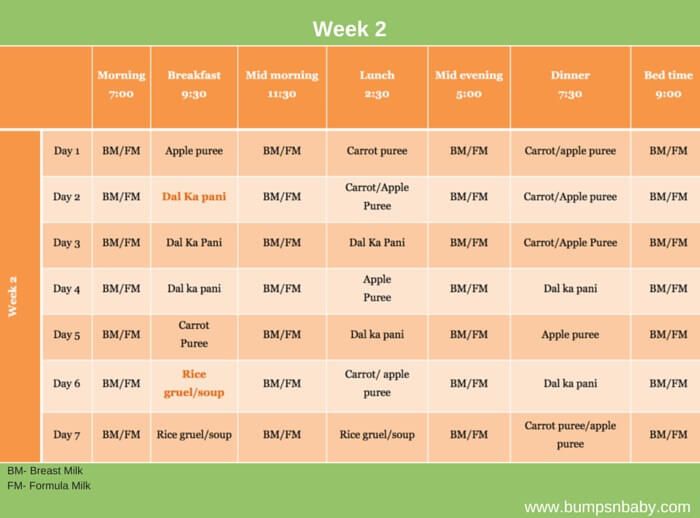
- Transfer the cooked potatoes to a bowl and mash them with a spoon.
- Add breast milk or formula milk.
- Delicious potato puree is ready.
7. Bottle Gourd (
Lauki) PureeIngredients:
- Bottle gourd – 1/2
- Moong dal – 1 tbsp
- Jeera powder – a pinch
How To Prepare:
- Wash and peel the lauki. Cut it into small cubes.
- Add the lauki cubes and moong dal to a pressure cooker with 50 ml of water.
- Cook for 2 whistles on medium flame.
- Mash or blend it after it cools down. Add jeera powder (optional) and serve.
Feeding Tips
Feeding babies can be a daunting task for mothers. Here are some tips to make your baby’s mealtime happy and stress-free.
- Always start with just one or two spoons and give more only if your baby likes the taste.
- Introduce only one new fruit or vegetable at a time and observe her reaction to it, before starting with another foodstuff.

- Follow the 3-day rule and note down all the new dishes and ingredients you’ve fed your baby. This makes troubleshooting easier if she has an allergic reaction.
- Do not lumpy foods or finger foods to babies as small as six months. It can sometimes cause gagging and even choking.
- Decide on a calm and quiet place for feeding like the living room or the kitchen.
- Avoid distraction feeding, i.e. don’t feed your baby by getting her to watch something on a TV or mobile screen.
- Prepare and store baby food in sterilised steel or glass bowls instead of plastic containers.
- Give only homemade food as your baby’s digestive system is still underdeveloped.
Introducing solid foods to babies can be tricky, and mothers may feel confused as to what food is right for their baby. Most of the time, babies love to eat foods that are of varying tastes, textures and colours. A little effort towards tingling their taste buds can go a long way in successful feeding.
Disclaimer:
- Each child is different and so use these meal plans as a trusted guide as per your discretion. You can modify the meals according to your child’s preferences / requirements.
- Never force-feed a child.
- While preparing formula, please follow the instructions on the box and use the measuring spoon provided with it.
- While introducing solid food to a baby, initially, one needs to prepare watery gruels/soups. As a child gets older, the caretaker/ mother has to increase the thickness of the liquids slowly according to the child’s capacity to swallow. Foods that are too thick can cause stomach upset/ unnecessary load; while excessively watery food might cause the child to remain hungry.
- Some kids may eat less on some days and that is absolutely alright. However, if a child eats less for more than 3-4 consecutive days, please visit a doctor to guide further.
- A child may eat less during the teething phase or if he/she may not be feeling well.
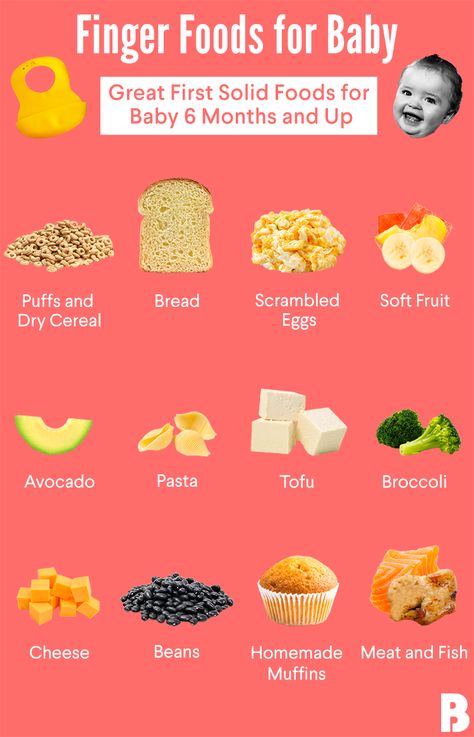 You could increase breast milk /formula feeds on those days. Re-introduce the foods once the child is back to normal.
You could increase breast milk /formula feeds on those days. Re-introduce the foods once the child is back to normal. - Don’t stop feeding if the child is suffering from diarrhoea.
- You can alter the taste of the food by adding some natural flavours like cinnamon, jeera powder, lemon juice, curry leaves etc. if the child doesn’t accept the food initially.
- If your child suffers from an allergy to nuts, gluten or eggs, please consult your doctor before feeding him/her any foods that may contain them.
Also Read: Food Ideas for 7 Months Old Baby
6 Months Baby Food Chart
Start your little one’s journey into solid foods the right way with our 6 months Baby Food Chart! Includes healthy and nutritious Indian recipes too!
Things to Remember before Weaning your Baby
Basic Tips for Feeding your 6 Month Old Baby:
6 Months Baby Food Chart with Indian Recipes
Week 1 – 6 Months Baby Food Chart
Week 2 -6 Months Baby Food Chart
Week 3- 6 Months Baby Food Chart
Week 4- 6 Months Baby Food Chart
How do you know that your baby has an allergy to a particular food?
What to do if your baby is allergic to a particular food?
Buy Healthy Nutritious Baby, Toddler food made by our own Doctor Mom !
So your baby is 6 months old – congratulations, she’s ready to start solid foods! Many Moms eagerly wait for that moment when their little ones start eating new foods.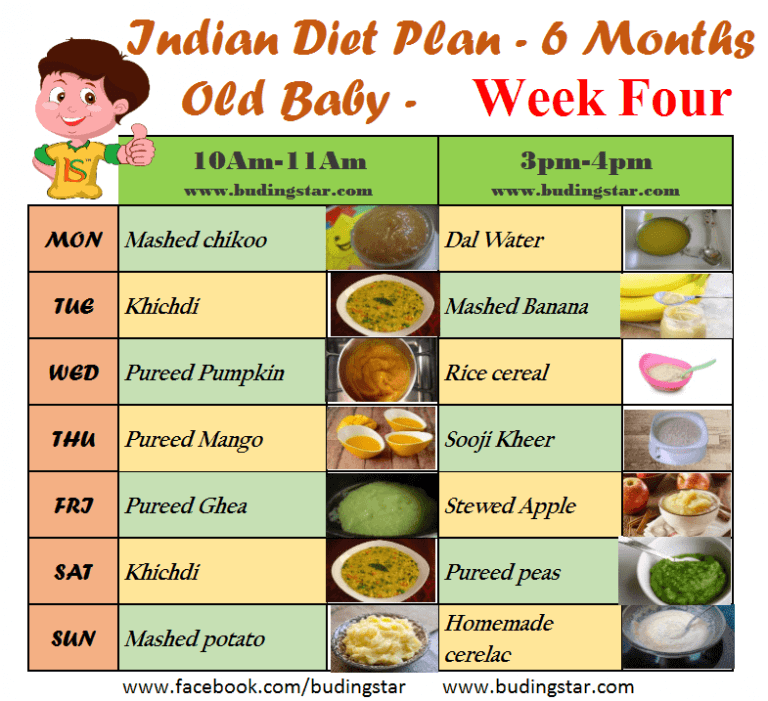 It’s so much fun to watch the expressions on those little faces change as they taste new flavors!
It’s so much fun to watch the expressions on those little faces change as they taste new flavors!
Things to Remember before Weaning your Baby
Be sure that your baby is ready for starting solids by checking her physical developmental milestones. Please remember that at this age, breast milk is still the major part of your baby’s diet. WHO recommends exclusive breastfeeding till 6 months of age, and breast milk to complement solids for the next year or more.
Make sure you are well prepared with all the essentials for weaning your baby.
Your baby’s immune system is still weak and she is vulnerable to all kinds of germ attacks. So, ensure that all your baby’s feeding utensils are absolutely clean and sterilized. If you’re confused about how to do it, then this video on how to sterilize the feeding utensils for babies should help.
Initially, it can be difficult to know exactly how much solid food for 6 month old . You don’t really need a lot of solid food for your baby at this age. About 90 ml per feed twice a day should be enough to begin with. Before starting out, you may want to check our post on how to introduce solids to Baby for some useful tips and tricks.
About 90 ml per feed twice a day should be enough to begin with. Before starting out, you may want to check our post on how to introduce solids to Baby for some useful tips and tricks.
Here is a look at the foods you can introduce this month:
Basic Tips for Feeding your 6 Month Old Baby:- You can make any of the purees or porridge runny by adding breast milk or formula milk
- Thicker purees will help add calories
- Follow a routine to feed baby, like tying on the bib, putting him in his chair, etc.
- Continue to breastfeed on demand
Here is the 6 months baby food chart for indian babies.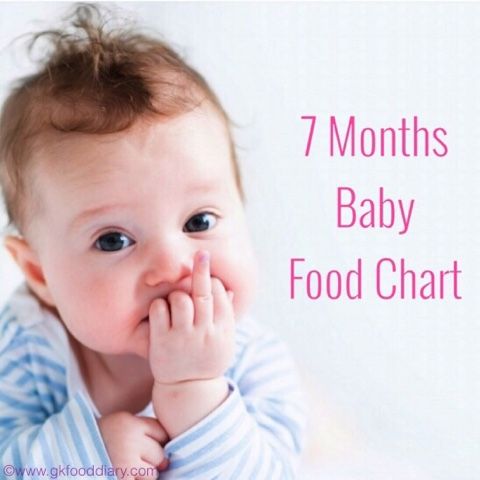
Week 1 – 6 Months Baby Food Chart
Day 1 – The best choice for a baby’s first food is fruit. Start with 1 tablespoon of Apple puree once a day.
Day 2 – Increase to 2 tablespoons of Apple Puree twice a day.
Day 3 – Increase to 3 tablespoons of Apple Puree twice a day.
Day 4 – You can now introduce a new solid, a vegetable. You can start with carrot, by giving 1 tablespoon Carrot Puree once a day.
Day 5 – Increase to 2 tablespoon of carrot puree twice a day.
Day 6 – Increase to 3 tablespoon of carrot puree twice a day.
Day 7 – Go with apple puree in the morning and carrot puree in the evening.
Week 2 -6 Months Baby Food Chart
Now that your baby has gotten used to a texture other than that of milk, you can continue with two solid meals a day. The recommended feeding schedule for 6 month old babies is somewhere during mid morning and early afternoon ,around 3:00 PM, but you can adjust it to your baby’s liking. You can find the recipes mentioned in the chart by clicking on the links below.
You can find the recipes mentioned in the chart by clicking on the links below.
Week 3- 6 Months Baby Food Chart
Continue with the same timings as earlier, with two solid meals per day. You can introduce some new grains, fruit and vegetables this week. Get the recipes of the dishes in the chart by clicking on the links below.
Week 4- 6 Months Baby Food Chart
This week, you can continue with baby’s familiar foods, and introduce some new ones. If anyone in the family has celiac disease, gluten intolerance or any kind of wheat allergy, talk to your doctor before introducing wheat. Get the recipes by clicking the links below.
Please note that these meal plans aren’t written in stone! This is just a guide that gives you an idea about what to feed your baby, when to feed and how much to feed. You can customize these meal plans to your baby’s convenience and routine. If she doesn’t like a food, wait a few weeks before introducing it again. Be patient, don’t expect your baby to polish off the plate at every meal! It’ll take another two months for her to completely finish the portions, so don’t try to force feed the remaining food on the plate.
However, do consider the risk of food allergies. You can’t be sure if your baby is allergic to any food, so always follow the 3 Day Rule before introducing any new food to your baby. This will also help you rule out any foods that are causing indigestion in your baby.
How do you know that your baby has an allergy to a particular food?
If a food doesn’t suit your baby, your baby may present with the following symptoms:
- Diarrhea
- Constipation
- Vomiting
- Rashes
- Incessant Crying (due to stomach pain)
What to do if your baby is allergic to a particular food?
If your baby is allergic to a particular food, stop it immediately and restart it after 2 months. At every point, be sure to follow the 3 day rule – whether introducing a new food or reintroducing an old one. You can start a “Baby Food Diary” to keep track of your little one’s favorite recipes and specific food allergies.
Please click this link for other 6 months Baby Food Recipes.
Looking for best first baby foods ? We have got you covered, I make baby food in my own kitchen and we sell through LittleMoppet Foods ! A brand of wholesome and pure homemade baby food products, made without preservatives, added flavors, added sugar or salt. 100% Organic & Natural.
No time to prepare baby food at home? Don’t worry, we prepare it hygienically and ship it to your doorstep. All food products are made FRESH only after the order is placed
Buy Now
Use these food charts and plan your baby’s meals using a Printable Meal Planner. You can also keep a “Baby Food Diary” to track your little one’s favorite recipes and food allergies if any.
If you wish to get a 6 months baby food chart pdf then you can sign up here
Check out 6 to 12 months baby food chart pdf here:
- 7 Months Baby Food Chart
- 8 Months Baby Food Chart
- 9 Months Baby Food Chart
- 10 Months Baby Food Chart
- 11 Months Baby Food Chart
- 1 Year Baby Food Chart
Many moms ask about food for 6 month baby to gain weight, we have covered that also in this article, let us know if you find it useful.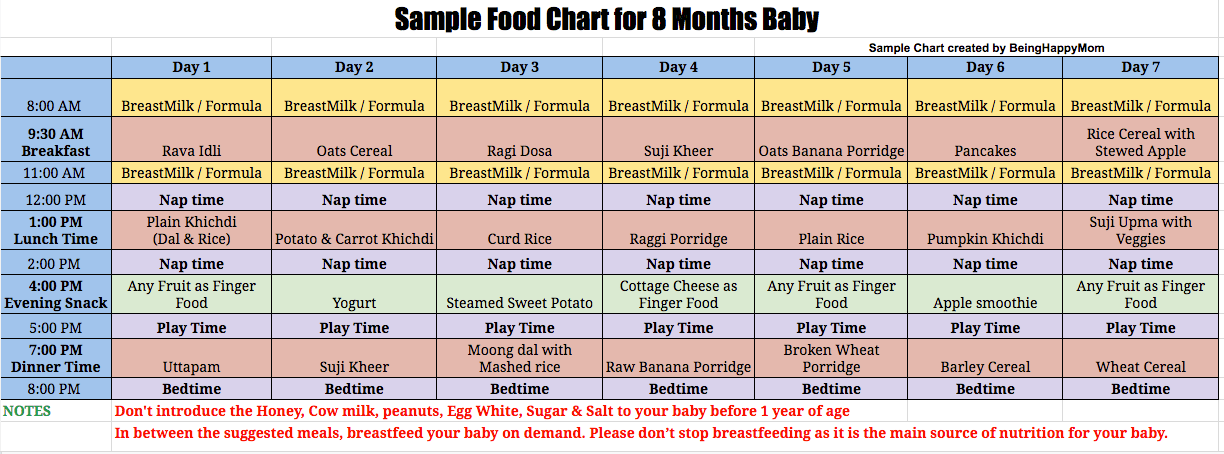
Post Updated on – 11 June 2019, 19 May 2021, 20 March 2022
Post first published on – 7
Make life easier with our eBook, ‘50 First Foods for Babies‘ that has recipes and meal suggestions for every stage of weaning. You can download it for free here.
The information presented here is meant to be a guide and does not replace professional medical advice. You should always discuss your baby’s dietary requirements with your doctor.
Buy Healthy Nutritious Baby, Toddler food made by our own Doctor Mom !
Shop now!diet for a 6-month-old baby with breast and artificial feeding, an approximate menu for a week in the table, a diet for a day
Published: 02/10/2021
Reading time: 4 min.
Number of reads: 173519
Author of the article: Ponomareva Yulia Vladimirovna
Pediatrician, Candidate of Medical Sciences, allergist-immunologist
Changes in a child in the first year of life are very rapid, and each month is not like another.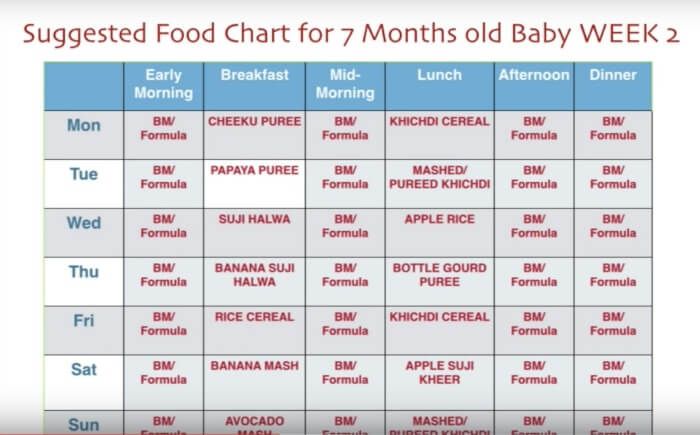 The 6-month milestone is very important, it is largely evaluative and transitional. By this age, most babies have doubled their birth weight, are about 15 cm tall, and some babies have already erupted their teeth. The age of 6 months is also transitional in terms of nutrition. Breast milk or an adapted formula is still the basis of the diet, but with the beginning of the second half of life, all children, without exception, should begin to receive complementary foods. Despite the general graph of growth and weight gain and indicators of psychomotor development, the status and diet of children at 6 months can be very different.
The 6-month milestone is very important, it is largely evaluative and transitional. By this age, most babies have doubled their birth weight, are about 15 cm tall, and some babies have already erupted their teeth. The age of 6 months is also transitional in terms of nutrition. Breast milk or an adapted formula is still the basis of the diet, but with the beginning of the second half of life, all children, without exception, should begin to receive complementary foods. Despite the general graph of growth and weight gain and indicators of psychomotor development, the status and diet of children at 6 months can be very different.
Content: Hide
- The first feeding of 6 months
- The start of complementary foods at 4-5 months
- The second half of the life
- for a week for a child at 6 months
The first feeding of
If the baby is healthy and breastfed, and his mother eats a full and varied diet, exclusive breastfeeding is possible until this age. Cereal complementary foods in this case are preferable to start. This is due to the high energy and nutritional value of cereals, the ability to significantly enrich the baby's diet with a delayed start of the introduction of complementary foods.
Cereal complementary foods in this case are preferable to start. This is due to the high energy and nutritional value of cereals, the ability to significantly enrich the baby's diet with a delayed start of the introduction of complementary foods.
However, the rate of expansion of the child's diet in this situation will be accelerated. Before the 8th month of life, it is necessary to introduce all basic food groups into the baby’s menu, since in the second half of the year the need for additional intake of nutrients and micronutrients is very high. Another reason explaining the importance of the rapid introduction of complementary foods is the formation of immunity of the immune cells of the intestine to ordinary food. If a child is introduced to these foods at the age of 4-8 months, the risk of developing food allergies has been proven to be reduced.
Complementary feeding starts at 4-5 months
In today's life, the nutrition of a nursing mother, unfortunately, is not always complete. Therefore, for most breastfed babies, complementary foods already need to be introduced from 5 months in order to prevent deficient conditions.
Therefore, for most breastfed babies, complementary foods already need to be introduced from 5 months in order to prevent deficient conditions.
If a child is bottle-fed, then by the 4th month of life, the baby will not have enough adapted formula alone, and in this group of children, the timing of the introduction of complementary foods usually shifts a month earlier than in breast-fed babies. Accordingly, by 6 months, children will have vegetable puree and gluten-free porridge (buckwheat, corn and rice) in their diet. In the first half of life, monocomponent meals are used (that is, from one type of grain and vegetables), prepared on the basis of water, breast milk or an adapted mixture.
Fruit puree and juice can be another possible complementary food for children under 6 months of age without allergy symptoms. In a child with a risk of developing or manifesting allergies, the timing of the introduction of fruit complementary foods is shifted to the 8th month.
Second six months of life
Children over 6 months of age can supplement their diet with cereals containing gluten. First of all, these are oatmeal and wheat porridge, and then multi-cereal dishes with the addition of other cereals (millet, barley, rye). If the child does not have any manifestations of allergies, milk porridge can be included in the menu at this age. Bebi Premium industrial baby food products include specially prepared milk that is safe to use in healthy babies in the first year of life.
First of all, these are oatmeal and wheat porridge, and then multi-cereal dishes with the addition of other cereals (millet, barley, rye). If the child does not have any manifestations of allergies, milk porridge can be included in the menu at this age. Bebi Premium industrial baby food products include specially prepared milk that is safe to use in healthy babies in the first year of life.
From the age of 6 months, the baby's diet is expanded with such important products as meat and cottage cheese. These products are a source of high-quality protein, fats, and are also rich in minerals such as iron, calcium, and phosphorus. Pediatricians and nutritionists recommend introducing meat and cottage cheese as part of combined dishes based on a fruit and vegetable and / or grain component in a ratio of 1 (cottage cheese / meat): 4–5 (fruits / vegetables / cereals).
To enrich the diet with polyunsaturated fatty acids in the second half of the year, the menu includes vegetable oil in the amount of 3–5 grams per day, which can be added to the complementary food dish. The volume of each feeding is approximately 150-170 ml, and the child can already stand up to 3.5 hours between meals.
The volume of each feeding is approximately 150-170 ml, and the child can already stand up to 3.5 hours between meals.
In the table below, we offer a menu of 6 months for a week for a child who started receiving complementary foods at the age of 4-5 months, and by the time the second half of life begins, dairy-free gluten-free cereals, vegetable and fruit purees have already been introduced into his diet.
1st day
| Seeing | 0065 50|||
| Lunch (12.30) | vegetable soup with beef, olive oil | 100/30/3 | compot of drocked 9006, 9006 9 |
| Afternoon snack (16.00) | Plum puree with cottage cheese | 60/40 | |
| Breast milk/formula | 60 062 | ||
| food reception | menu | ml/g | |
| Early morning | breast milk/mixture | 150 | Milki | & Bashas Breakfast (09 cherry Bebi Premium» | 100 |
| 0065 Breast milk/mixture | 150 | ||
| children's soluble cookies "BEBIKI" Classic | |||
| GRUSHERS with rice and Claus | GRUSHIOUS WITH RISE and CRETURE 30 | ||
| Bebi Premium Kids Instant Herbal Tea | 50 | ||
| Bedtime 065 Breast milk/formula | 150 | ||
Rate the article
(Number of votes: 20, average 4.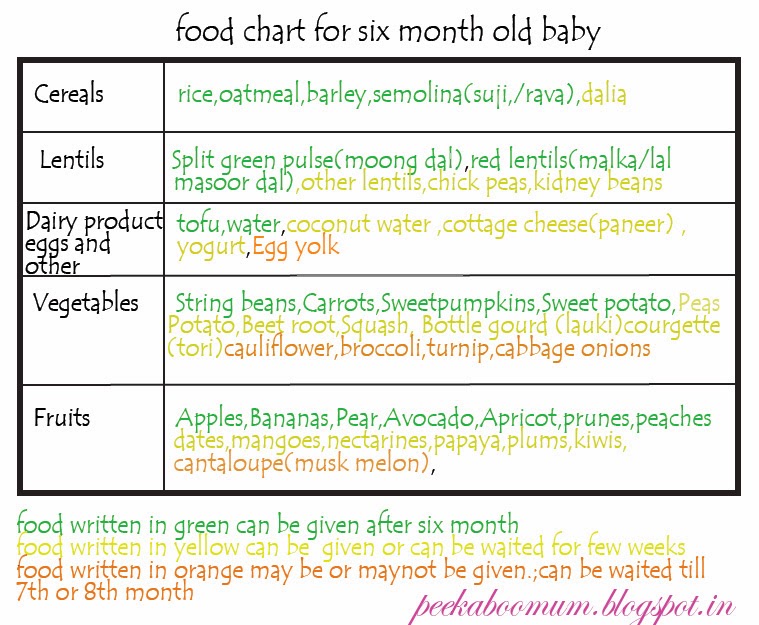 8)
8)
Share with friends:
Menu for a 6 month old baby
| The author of the menu for a child of 6 months pediatrician Marina Turupaeva Marina. Experience 11 years. Twice mother. Graduated from the Yaroslavl State Medical Academy. District pediatrician of the children's polyclinic, chief district pediatrician, neonatologist of the maternity ward. She teaches at the “School of Motherhood” and works with expectant mothers on children's health issues. |
Today, probably, only the lazy one does not give advice on how to feed a child and what should be on the menu of a six-month-old baby. It is interesting that there are a lot of opinions on this topic and, perhaps, it is sad that even medical professionals often give different nutritional recommendations from each other. What is a young mother to do?
What should be on the menu of a 6 month old baby?
How to choose the right option and, most importantly, how not to harm your baby?
I am a pediatrician and mother of two children.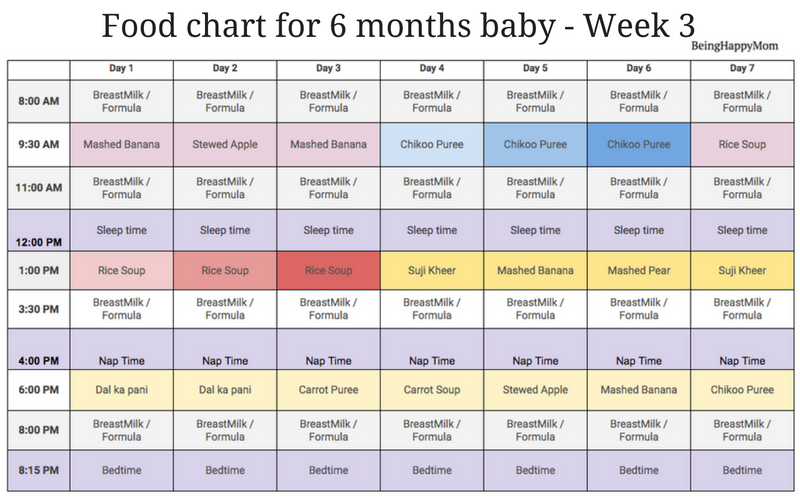 When my eldest daughter was born, I had no time to think about what to feed her, I then listened to my mother and, despite my medical education, relied only on her experience. After all, she raised her children and knows better. As a result, I got digestive problems and allergies in my baby. Which only added to the difficulty for me.
When my eldest daughter was born, I had no time to think about what to feed her, I then listened to my mother and, despite my medical education, relied only on her experience. After all, she raised her children and knows better. As a result, I got digestive problems and allergies in my baby. Which only added to the difficulty for me.
When I was pregnant with my son, even then I began to think about how to avoid most of the problems in the first year of his life. After all, as they say in a well-known advertisement, when the baby is comfortable, then his mother is happy and calm. I'll tell you honestly, having a medical education interferes with my life in many ways, because you know less - you sleep better. However, it also certainly helps by the fact that I can delve into the essence of the process taking place in the child’s body literally at the cellular level. Now it will not be enough for me only someone's experience. Exact explanations and justifications are needed. And friends, I figured it out. As you know, science is moving and what was considered useful 5-10 years ago has now turned out to be unhelpful, and some even harmful. Today I really want to share with you my observations and modern aspects in the nutrition of children at the age of 6 months.
As you know, science is moving and what was considered useful 5-10 years ago has now turned out to be unhelpful, and some even harmful. Today I really want to share with you my observations and modern aspects in the nutrition of children at the age of 6 months.
I really hope that until 6 months your baby had only breast milk on the menu. If so, then get your grade, you are “five plus”. If you are feeding your baby only an adapted milk formula because for some reason you had to stop breastfeeding, you also get a high five. I imagine and have experienced in my own skin what it is like to resist the pressure of all close and not very close relatives, girlfriends, neighbors and just acquaintances. "What, you're not giving the baby juice yet?" or “Have you tried egg yolks yet? Poor child!".
I want to praise you and say that you did absolutely the right thing, that you did not succumb to their provocations and did not cause problems with the chair and sleep in your own child.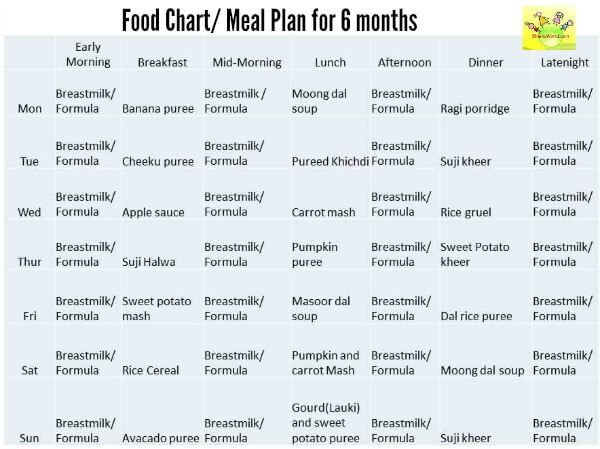
Rule #1.
Until the age of 6 months, the baby does not need any food, except breast milk or adapted formula.
Withstood, withstood. What's next? It is necessary to decide on the product of the first complementary foods. Considering all modern research and observations, porridge is the ideal first complementary food product. They are easily absorbed by his immature children's body and cause the least number of allergies.
Rule #2. We start with porridge.
Which porridge to choose? Pediatricians around the world advise starting with gluten-free cereals, these are buckwheat, rice and corn porridge. Why is gluten dangerous? In a nutshell, these are abdominal pains, bloating, diarrhea, as well as an allergic reaction in the form of a skin rash and many other various unpleasant symptoms. I hope I convinced you, we will postpone gluten cereals for later.
What does complementary feeding look like? We start giving any new product with 1 teaspoon to assess the child's reaction to it.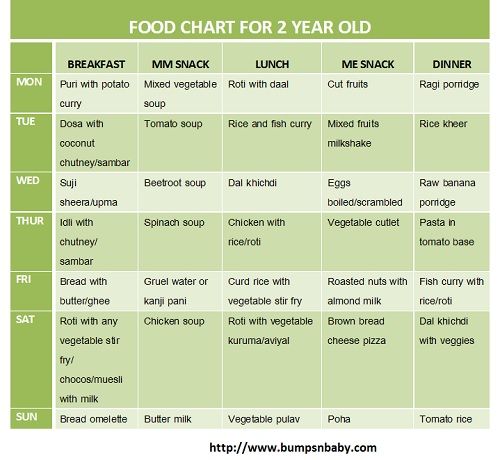 If the stool and sleep are not disturbed, and the skin remains clean, gradually increase the amount of porridge eaten and bring it to a full serving, replacing one breastfeeding or formula, that is, up to 200 ml.
If the stool and sleep are not disturbed, and the skin remains clean, gradually increase the amount of porridge eaten and bring it to a full serving, replacing one breastfeeding or formula, that is, up to 200 ml.
Rule #3. Start with 1 teaspoon and increase gradually!
In our shops there is a great variety of different boxes with cereals. There are dairy and dairy-free, from one cereal and several, with and without fruits. You can get confused, so which one to choose? We always start with monocomponent porridge without milk and fruits. And why spend money on these new-fangled boxes, if you can cook porridge yourself. Then you will be 100% sure of its composition. Just take the selected cereal and grind it in a coffee grinder. You will get flour, which you will then cook.
Recipe for buckwheat porridge.
Take 2 tsp. buckwheat flour, dissolve in 2 tbsp. warm boiled water, stir so that there are no lumps, and pour into 120 ml of boiling milk.



